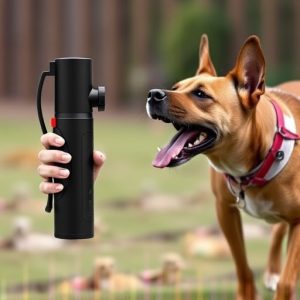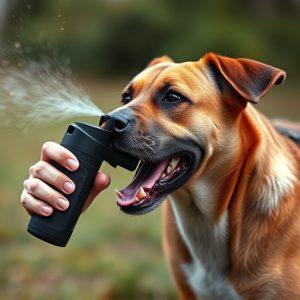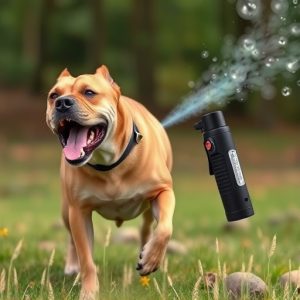Dog Deterrent Spray Range: Science, Application & Legal Aspects
Dog deterrent spray uses capsaicin, citroenellal, and pyrethrum to control dog behavior without harm…….
Dog deterrent spray uses capsaicin, citroenellal, and pyrethrum to control dog behavior without harm. Effectiveness varies with weather conditions, so targeted nozzles are crucial for safety. Select products designed for canines, follow instructions, apply along entry points, and reapply regularly. Adhere to legal guidelines, prioritize ethics, and consider alternatives for humane, safe coexistence between humans and dogs, focusing on safety features in canine repellent.
“Unveiling the Effective Range of Dog Deterrent Spray: A Comprehensive Guide. Dog deterrents have emerged as powerful tools for managing canine interactions, but understanding their range and application is key to effective usage. This article delves into the science behind dog deterrent spray, exploring active ingredients, factors influencing its distribution, and best practices for safe and efficient use. We also dissect legal considerations, ethical guidelines, and real-world case studies, highlighting safety features in canine repellent for responsible, effective dog deterrence.”
- Understanding Dog Deterrent Spray: Active Ingredients and Their Role
- The Science Behind Effective Range: Factors Influencing Spray Distribution
- Best Practices for Application: Ensuring Safety and Maximizing Results
- Legal Considerations and Ethical Use: Responsible Application of Canine Repellent
- Case Studies: Real-World Success Stories in Dog Deterrence
Understanding Dog Deterrent Spray: Active Ingredients and Their Role
Dog deterrent spray, also known as canine repellent, is a popular tool for managing and controlling dog behavior in public spaces. These sprays are designed to deter dogs from approaching or engaging in unwanted behaviors, such as barking, jumping, or even aggression. Understanding the active ingredients and their roles is essential when considering the effectiveness of these repellents.
Safety features in canine repellent are a key concern for users. Common active ingredients include capsaicin, which is derived from chili peppers, and synthetic analogs like citroenellal and pyrethrum. These substances work by mimicking natural irritants that dogs find unpleasant, without causing them any lasting harm. When used correctly, dog deterrent sprays can effectively navigate the delicate balance between deterring canine behavior and maintaining safety for both humans and animals.
The Science Behind Effective Range: Factors Influencing Spray Distribution
The effectiveness of dog deterrent spray, often known as canine repellent, depends on a complex interplay of factors, giving rise to its range and impact. Understanding the science behind this is crucial when considering safety features in such products. The distribution of the spray is influenced by various elements, including atmospheric conditions like wind speed and direction, humidity levels, and temperature. These environmental variables can significantly alter the spray’s path and duration, impacting its overall reach.
Additionally, the design of the nozzle and the spray mechanism play a pivotal role. Advanced safety features in canine repellents incorporate specific mechanisms to control the spray pattern and distribution. Some nozzles are designed to emit a fine mist, ensuring the spray stays close to the ground and lingers longer, thereby increasing its effective range. This tailored approach not only enhances the product’s efficiency but also minimises potential harm to non-target species and human users by keeping the application targeted and safe.
Best Practices for Application: Ensuring Safety and Maximizing Results
When using dog deterrent spray, best practices center around safety and maximizing its effectiveness. Begin by selecting a product designed for canine repellent, ensuring it contains safety features like controlled release mechanisms to prevent overspraying and inhalation of harmful chemicals. Always follow manufacturer instructions regarding application methods and frequency, as proper usage is key to both safety and success.
Spraying in strategic locations, such as fence lines or entry points where dogs are known to enter, can deter them from specific areas. Additionally, regular reapplication is crucial; depending on environmental factors like wind and rain, the spray’s effectiveness may diminish over time. Consistent use and proper application techniques will help maintain a safe, dog-free environment while ensuring the humane treatment of animals.
Legal Considerations and Ethical Use: Responsible Application of Canine Repellent
When considering the use of dog deterrent spray, it’s crucial to be aware of legal and ethical guidelines that govern its application. Each jurisdiction has specific rules regarding the use of such repellents to ensure public safety and protect both animals and humans. It’s essential for users to understand these regulations, especially concerning the effective range and concentration of the spray.
Responsable application involves adhering to safety features in canine repellent products. This includes using them only as intended, avoiding excessive usage, and respecting the boundaries of the legal permissible range. Ethical use requires considering alternatives before resorting to repellents, ensuring that no harm comes to unsuspecting animals or individuals, and being mindful of environmental impact. By following these guidelines, users can contribute to a safer and more harmonious coexistence between humans and dogs.
Case Studies: Real-World Success Stories in Dog Deterrence
Dog deterrent spray has proven effective in various real-world scenarios, offering a safe and humane solution for managing canine behavior. Case studies across different settings have showcased its success in deterring dogs from unwanted areas, such as gardens, patios, and even public spaces like parks. One notable example involves homeowners who had been dealing with persistent neighborhood dogs entering their yards. By employing a dog deterrent spray with specific safety features designed to protect both the target area and non-target species, they achieved significant results. The spray’s quick-acting formula disrupted the dogs’ behavior without causing harm or long-term stress, leading to a marked decrease in unwanted visits.
Another successful implementation was observed in public parks where loose dogs were a recurring issue. Park management teams utilized dog deterrent sprays tailored for open spaces, ensuring minimal impact on other wildlife and park goers. The strategic application of these repellents created a safe haven, encouraging responsible pet ownership and reducing instances of canine-human conflict. These real-world success stories underscore the effectiveness and safety features inherent in modern dog deterrents, making them valuable tools for managing canine populations and maintaining public safety.
Dog deterrent spray, with its active ingredients and precise application techniques, offers an effective solution for managing canine intrusions. By understanding the science behind its range and best practices for application, users can ensure both safety and optimal results. Legal considerations underscore responsible use, and case studies demonstrate the real-world success of this method in various scenarios. Incorporating these insights empowers individuals to make informed decisions, leveraging the power of canine repellent while adhering to safety features.


